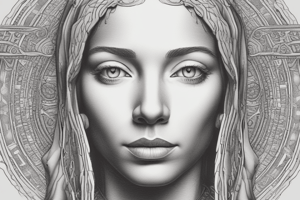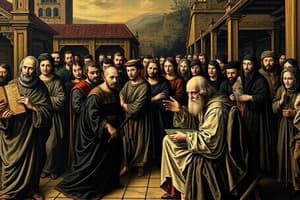Podcast
Questions and Answers
What was the primary way artists supported themselves historically?
What was the primary way artists supported themselves historically?
- By selling their work to the general public
- By working multiple jobs
- By relying on wealthy patrons (correct)
- By creating only digital art
What was a major impact of the printing press on art?
What was a major impact of the printing press on art?
- Artists could create more original works
- The printing press made art more exclusive
- Only digital art was produced
- Only the wealthy could afford to own a large collection of books or music (correct)
What was established by the 1886 Berne Convention?
What was established by the 1886 Berne Convention?
- That only digital art is protected
- That the creator of an original work has exclusive rights (correct)
- That only wealthy artists have rights
- That patrons own the work, not the creator
What is a major challenge artists face in the digital age?
What is a major challenge artists face in the digital age?
Why is it essential to respect artists' rights?
Why is it essential to respect artists' rights?
What was the primary goal of wealthy patrons in supporting artists?
What was the primary goal of wealthy patrons in supporting artists?
How many countries have signed the Berne Convention?
How many countries have signed the Berne Convention?
What is a consequence of piracy and copyright infringement?
What is a consequence of piracy and copyright infringement?
What was a limitation of the printing press?
What was a limitation of the printing press?
What is the result of respecting intellectual property rights?
What is the result of respecting intellectual property rights?
Flashcards are hidden until you start studying
Study Notes
The Struggle of Living off One's Art
- Many artists struggle to earn a living from their creations due to the time and resources required to produce their work.
- Historically, artists relied on wealthy patrons ( mecenas ) to support their work, but this meant they had to cater to the patron's tastes and needs.
The Impact of the Printing Press
- The invention of the printing press in the 15th century made it possible to mass-produce artistic works, but only the wealthy could afford to own a large collection of books or music.
The Evolution of Intellectual Property Rights
- Before the 1886 Berne Convention, many believed that the person who paid for a work owned it, not the creator.
- The Convention established that the creator of an original work has exclusive rights to reproduce, translate, adapt, and distribute their work.
- The Convention has been signed by 160 countries, ensuring that authors have more protection and recognition for their work.
The Challenges of the Digital Age
- The internet has revolutionized the way we consume art, but it has also led to piracy and copyright infringement.
- Piracy harms artists and society as a whole, as they cannot earn a living from their work and may have to seek other employment.
The Importance of Respecting Intellectual Property Rights
- It is essential to respect artists' rights and acknowledge their work to ensure they can continue to create.
- By respecting intellectual property rights, we can safeguard the livelihoods of artists and ensure that they can continue to produce work that enriches our lives.
The Struggle of Living off One's Art
- Artists face challenges in earning a living from their creations due to the time and resources required to produce their work.
- Historically, artists relied on wealthy patrons (mecenas) to support their work, sacrificing creative freedom.
The Impact of the Printing Press
- The 15th-century invention of the printing press enabled mass production of artistic works.
- Only the wealthy could afford to own a large collection of books or music, limiting access.
The Evolution of Intellectual Property Rights
- Before the 1886 Berne Convention, patrons believed to own the work, not the creator.
- The Berne Convention established the creator's exclusive rights to reproduce, translate, adapt, and distribute their work.
- 160 countries have signed the Convention, protecting authors' rights and recognition.
The Challenges of the Digital Age
- The internet has revolutionized art consumption, but also facilitated piracy and copyright infringement.
- Piracy harms artists and society, as they cannot earn a living from their work, leading to alternative employment.
The Importance of Respecting Intellectual Property Rights
- Respecting artists' rights and acknowledging their work ensures they can continue to create.
- Protecting intellectual property rights safeguards artists' livelihoods, enabling them to produce enriching work.
Studying That Suits You
Use AI to generate personalized quizzes and flashcards to suit your learning preferences.




